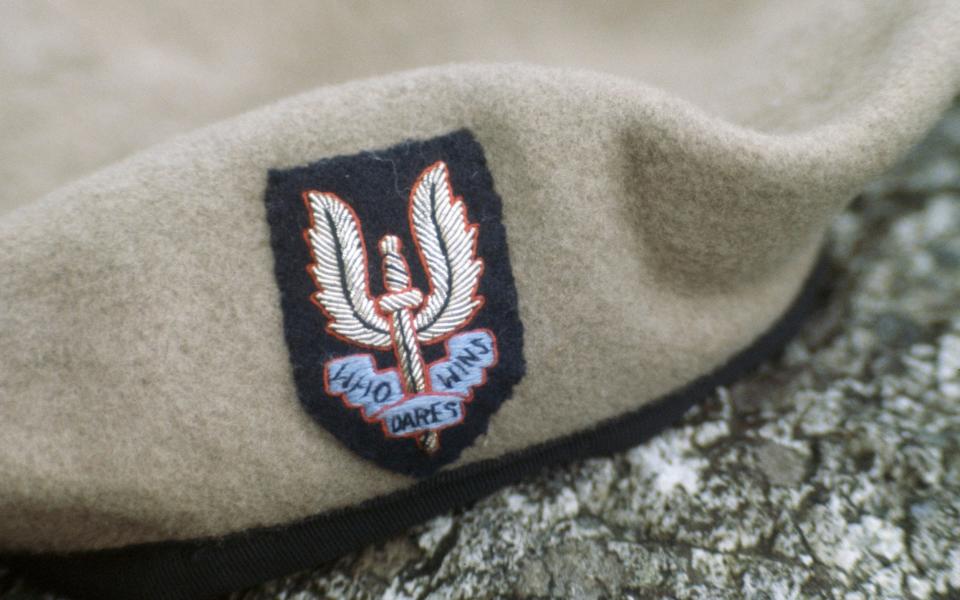There has always been an intense rivalry between the Special Air Service and the Special Boat Service.
Such competition is not too surprising. Both units – along with the Special Reconnaissance Regiment – are what the military calls “Tier One” organisations and each is brimming with the most alpha of alpha males.
To the SAS, the SBS are known derisorily as the “Shaky Boats Service” – typically shortened to just the “Shakies”. And to the SBS, the SAS are often seen as the gloryboys – a unit often credited for every covert mission, irrespective of whether they were involved or not, from a public largely unattuned to the variety of units that make up the UK’s special forces.
But tensions between the two now seem to have spilled over into almost open warfare amid reports SBS officers accused their SAS counterparts of having committed war crimes in Afghanistan more than a decade ago as the unit aggressively pursued the Taliban.
ADVERTISEMENT
Those allegations are at the centre of an ongoing public inquiry into the SAS, which is investigating claims that troops belonging to the regiment executed as many as 80 civilians in Afghanistan between 2010 and 2013. Court papers released last week revealed the probe was initially triggered by concerns raised from within the rival SBS.
A former senior UK Special Forces officer told the inquiry that the SAS had a “golden pass allowing them to get away with murder” during operations in the country. The accusation was published by the inquiry, led by Lord Justice Haddon-Cave, as part of a release of material summarising seven closed hearings with members of UK Special Forces.
The senior officer was one of several who registered concerns back in 2011 that the SAS appeared to be carrying out executions and covering them up. In one email from the time, the officer wrote that the SAS and murder were “regular bedfellows” and described the regiment’s official descriptions of operational killings as “quite incredible”.
Giving evidence to the inquiry behind closed doors in 2024, he and others went on to describe deep concerns that the SAS, fresh from aggressive, high-tempo combat in Iraq, was being driven by kill counts – the number of rival combatants eliminated in each operation.

None of those accusing the special forces of murder were actually present when the alleged crimes took place and critics of their accounts, such as Decorated SAS veteran James Deegan, have dismissed them as the result of “professional jealousy”. Deegan accused those who had given evidence to the inquiry of peddling “supposition, casual stories and bar-room bulls—-”.
ADVERTISEMENT
But the troops’ testimony appears to be unwavering. Another senior officer who gave evidence was asked whether he stood by concerns initially raised in 2011 that the SAS was carrying out extra-judicial killings. “I thought, and think, that on at least some operations [the SAS] was carrying out murders,” he said.
A junior officer who also gave evidence to the inquiry behind closed doors described a historic conversation in which a member of the SAS who had recently returned from Afghanistan told him about a pillow being put over the head of someone before they were killed with a pistol. “I suppose what shocked me most wasn’t the execution of potential members of the Taliban, which was of course wrong and illegal, but it was more the age and the methods and, you know, the details of things like pillows,” the junior officer said.
He alleged that some of those killed by the SAS had been children, according to the conversation he relayed. Asked by the inquiry if he meant some of those killed would be as young as 16, he replied: “Or younger 100 per cent”.
‘Rivalry at every level’
The explosive claims levelled by Special Forces officers has led to the largest crisis in the SAS’s illustrious 84-year history, with the outcome of the inquiry led by Lord Justice Haddon-Cave expected to have huge implications for the UK’s elite military units.
ADVERTISEMENT
It takes at least six months to become a member of either the SAS and the SBS and only 10 percent of volunteers, representing the very best the armed forces has to offer, eventually get through. The end result is a cadre of troops regarded as being of unequalled fighting prowess.
Until recently, the SBS recruited exclusively from the Royal Marines, while the SAS was almost entirely composed of soldiers, approximately 50 percent of whom were from the Parachute Regiment. The rivalry between the Paras and the Marines, who still make up the majority of troops in the SBS, is legendary.

Today, however, there is just one selection process and both units are required to train and fight alongside each other. Anyone wishing to join either the SAS or the SBS has to complete the UK Joint Special Forces selection programme. Those who pass then choose which regiment they wish to serve in.
“There are few wallflowers in the special forces,” one former non-commissioned officer tells The Telegraph. “They are composed of very intelligent, driven people, who are at the very top of their game.
ADVERTISEMENT
“Everyone has a pretty big personality and there are plenty of egos that need to be managed,” the officer adds. “There is rivalry at every level – most of it healthy.”
Insiders suggest the point at which intense professional rivalry between the SAS and SBS began to develop into something more venomous – and potentially damaging – can be traced back to the “toxic personalities” held by rival commanders serving in the special forces during the height of the war on terror.
The SAS 2009 deployment to Afghanistan, in particular, seems to have been a turning point. That deployment came after the SAS had already assumed control from the SBS as the lead British unit in Iraq, where Task Force Black and then Task Force Knight hunted down al-Qaeda operatives. The tempo of their operations was intense, with the then-Commanding Officer of the SAS insisting that his men were “out every night”. General David Petraeus would later describe the unit as doing a “phenomenal job” in Baghdad by effectively eliminating the al-Qaeda car bomb gangs who had killed hundreds.
While the SAS set about its work in Iraq, the SBS was given the challenge of leading covert operations in Afghanistan. But the roles changed again three years later, in 2009, when the SAS was sent in to lead counter-terror operations aimed at rooting out the Taliban.
One military source claims the move was forced through by the head of the SAS at the time, who wanted to build on the success his unit had achieved in Iraq, and apply it to Afghanistan.
But it was a shift which annoyed many within the hierarchy of the SBS, which was still active in the country. One former SAS officer who was serving at the time says that the rivalry between the two units’ senior commanders was obvious.
“At a junior officer level we are all generally great friends,” he says. “Operationally as a troop commander and a squadron commander, I had no sense that there was a rivalry at my level. You just wanted to get through a tour without losing anybody and try to make a real difference in the theatre you were in, which for me was both Iraq and Afghanistan.
“The rivalry became pretty serious though at a much more senior level, especially as the SAS took over Task Force Knight in Iraq and the SBS stopped rotating into Iraq and were responsible for Afghanistan.
“Then as Iraq quietened down there was this push for the SAS to go to Afghanistan. There was definitely a sense at the time that due to the tempo and frequency of operations against al-Qaeda in Iraq that the SAS was ‘better’. There was a definite air [amongst the SAS] of ‘we are going to hammer the Taliban like the SBS never could’”.
‘A complete breakdown of trust’
Another former SAS officer says such rivalry was so intense that it extended beyond the dividing lines of units, and into different parts of the SAS itself.
“Every squadron really believed they were the best. The competition was immense but you find that in all the best units. Look at the Paras – there is huge rivalry between 1, 2 and 3 Para, but in reality they are all unified under the airborne maroon beret. I would say it was, in my experience, similar for the SAS and SBS.
“But there were plenty of people I served with who didn’t think the SBS were up to the challenge,” the officer adds. “It [the rivalry] was certainly present at the command level – there were people in the SBS who seriously resented the commanding officer of the SAS at the time and there was a clash of some pretty toxic leadership personalities.
“I think this stemmed from operations in Iraq, before I was in the SAS, when mistakes were made.”
The first signs of public discord between the two regiments emerged in 2004, when a spat between the SAS and the SBS over a bungled operation in Iraq played out in the British press.
It broke out after a newspaper report quoted a then-serving member of the SAS as suggesting that SBS troops were incompetent and lacked courage. The report said that the SBS’s inexperience culminated in a 40-man squadron belonging to the unit being ambushed in March 2003 by Saddam Hussein’s Republican Guard.
It alleged SBS troops had failed to return fire during the incident in western Iraq and abandoned expensive equipment, including their “Pinky Land Rovers”. The vehicles, painted pink as a form of desert camouflage, were reportedly later paraded on Iraqi television.
“They [the SBS troops] cocked it up, panicked and did a runner. For the first time they came under effective enemy fire. [And] people were not impressed with their reactions,” the former member of the SAS was quoted as saying.
The accusation led to a furious response from the SBS, which countered that its troops had fought heroically after being double crossed by Iraqi spies who had posed as interpreters. The row became so intense that the then-Director of Special Forces, who at the time was an Army Brigadier, was forced to intervene.
“The Director of Special Forces has made clear to the commanders of both services that accusations of cowardice will not be tolerated and that anyone attempting to discredit either the SAS or SBS – which were both formed in 1941 – only succeeds in discrediting the whole of the Special Forces Group,” a source in the Ministry of Defence was quoted as saying.
Two decades on, as the current row rages, that warning rings as true as ever. But some insiders fear it may already be too late to heed as the explosive allegations aired at the inquiry into alleged SAS war crimes in Afghanistan continue to reverberate.
“I’m not entirely sure there is a way back from this,” one former SAS Sergeant Major tells The Telegraph. “There is absolute disbelief within the SAS that this has happened. The damage is huge. I would say that there has been a complete breakdown of trust between the two units and that is not good for the Special Forces or the country.”
EMEA Tribune is not involved in this news article, it is taken from our partners and or from the News Agencies. Copyright and Credit go to the News Agencies, email news@emeatribune.com Follow our WhatsApp verified Channel




